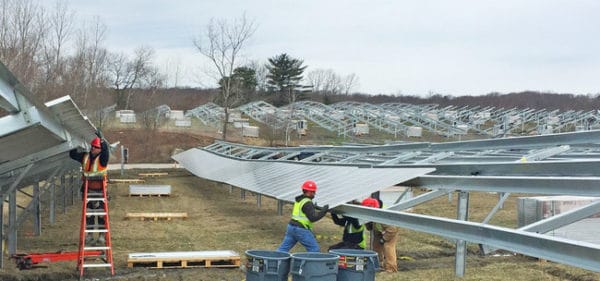In a prehearing brief filed with the U.S. International Trade Commission (ITC), the Solar Energy Industries Association (SEIA) urged the Biden Administration to phase out the Section 201 global safeguard tariffs on imported solar cells and modules.
SEIA submitted the brief in advance of a USITC hearing November 3 during which the Commission will hear arguments on the effectiveness of the Section 201 tariffs. The 143-page public version was edited by the trade group to remove information that it considered confidential in nature. In the next few weeks, the Commission will make a recommendation to President Biden on whether to extend, modify, or phase out the tariffs.
The tariffs, imposed by President Trump in January 2018, have produced “marginal investments” in domestic module assembly facilities that “fall well short” of the capacity needed to serve U.S. demand and meet President Biden’s climate and clean energy goals, SEIA said in a statement. They also failed to create jobs, instead resulting in “significant” job losses.

Image: SEIA
In August, Hanwha Q CELLS USA, Inc., LG Electronics USA, Inc., and Mission Solar Energy asked the ITC to extend import tariffs on crystalline silicon photovoltaic (CSPV) cells.
The petition was made under Section 204(c) of the Trade Act of 1974 and Subpart F of part 206 of the rules of practice and procedure of the ITC. The companies said that they are representatives of the domestic industry producing CSPV cells and modules and, therefore, have standing to file the petition.
Days earlier, Auxin Solar and Suniva formally asked the ITC to extend solar tariffs for four more years.
At the time, Mamun Rashid, co-founder and CEO at Auxin Solar said that “extending this safeguard is essential for America to reclaim its lead in solar energy manufacturing and development, and it represents a critical step to achieve the broader goal of American renewable energy independence.” Rashid said that Auxin was “committed to re-shoring the solar supply chain” and filed the petition hoping that policymakers would be “committed to the promise of green energy independence and the good-paying manufacturing jobs that will result.”
The ITC is expected to report its determination to President Biden by December 8.
‘Not one cent’
A tariff extension would be “yet another barrier” to clean energy deployment and will “undermine any hope” the U.S. has to mitigate the climate crisis, said SEIA president and CEO Abigail Ross Hopper. She said the U.S. has collected $2.6 billion in Section 201 solar tariffs, but “not one cent of that helped the domestic manufacturing industry.”
She said that U.S. lost 6,000 solar manufacturing jobs over the last four years. Proponents of the tariffs “promised we’d create more than 45,000 jobs.”
The jobs report said the drop was largely split evenly among states. Labor productivity rose in all three market segments, up 19% in the residential sector, 2% in the non-residential sector, and 32% in the utility-scale sector. Less labor-intensive utility-scale installations contributed to a record amount of solar capacity added in 2020, the report said.
However, the pandemic took a toll on residential jobs in the summer of 2020, the report said, and those jobs did not fully recover by the end of the year.

Courtesy Conti Solar
The report also said that labor productivity improvements were a result of growth in average system size, less labor-intensive customer acquisition, and increased competition for skilled labor. In 2020, the average worker installed more than 200 kW of solar, double the amount in 2017, and more than three times the amount recorded in 2011.
SEIA now argues that since the Section 201 tariffs were imposed in 2018, the U.S. solar industry has “missed out on” more than 62,000 jobs, $19 billion in private sector investment, and more than 10 GW of solar deployment. “Extending the tariffs will compound these economic losses and worsen the supply chain bottlenecks that are already throttling America’s clean energy sector.”
Hopper said, “The solar industry is already facing major supply chain constraints.” She said that extending the Section 201 tariffs “will only exacerbate these problems, prevent President Biden from reaching his clean energy goals, and worsen the global climate crisis.”
This content is protected by copyright and may not be reused. If you want to cooperate with us and would like to reuse some of our content, please contact: editors@pv-magazine.com.








Printing and tariffing our way to prosperity. LOL!